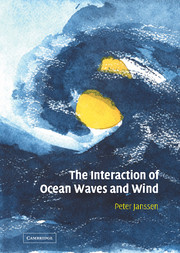4 - Nonlinear wave–wave interactions and wave dissipation
Published online by Cambridge University Press: 06 October 2009
Summary
In this chapter we study the effects of nonlinearity on the evolution of deep-water gravity waves. Eventually this will result in an expression for the source function for nonlinear wave–wave interactions and dissipation (presumably by white capping), which completes the description of the energy balance equation.
We shall begin with a fairly extensive discussion of nonlinear wave–wave interactions, followed by a brief treatment of dissipation of wave energy by white capping. The latter treatment is only very schematic, however, because this process involves steep waves which only occur sporadically. At best the choice of the white-capping source function can be made plausible. It turns out that the overall dissipation rate is in agreement with observed dissipation rates. Much more is known regarding nonlinear wave–wave interactions. An important reason for this is that ocean waves may be regarded most of the time as weakly nonlinear, dispersive waves. Because of this there is a small parameter present which permits the study of the effect of nonlinearity on wave evolution by means of a perturbation expansion with starting point linear, freely propagating ocean waves. In addition, it should be pointed out that the subject of nonlinear ocean waves has conceptually much in common with nonlinear wave phenomena arising in diverse fields such as optics and plasma physics. In particular, since the beginning of the 1960s many people have contributed to a better understanding of the properties of nonlinear waves, and because of the common denominater we have seen relatively rapid progress in the field of nonlinear ocean waves.
- Type
- Chapter
- Information
- The Interaction of Ocean Waves and Wind , pp. 129 - 208Publisher: Cambridge University PressPrint publication year: 2004



